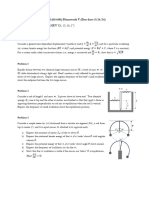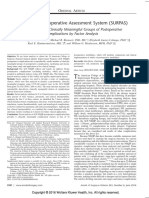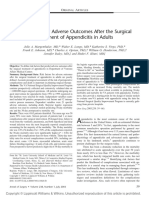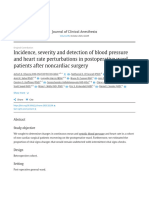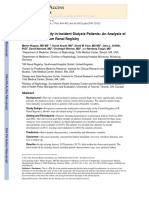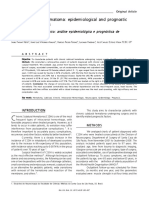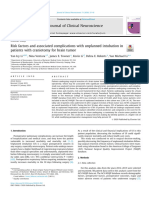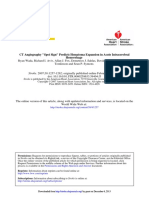Adam M. Lukasiewicz, MSC, Ryan A. Grant, MD, MS, Bryce A. Basques, MD, MHS, Matthew L. Webb, Ab, Andre M. Samuel, Bba, and Jonathan N. Grauer, MD
Adam M. Lukasiewicz, MSC, Ryan A. Grant, MD, MS, Bryce A. Basques, MD, MHS, Matthew L. Webb, Ab, Andre M. Samuel, Bba, and Jonathan N. Grauer, MD
Uploaded by
Bruno MañonCopyright:
Available Formats
Adam M. Lukasiewicz, MSC, Ryan A. Grant, MD, MS, Bryce A. Basques, MD, MHS, Matthew L. Webb, Ab, Andre M. Samuel, Bba, and Jonathan N. Grauer, MD
Adam M. Lukasiewicz, MSC, Ryan A. Grant, MD, MS, Bryce A. Basques, MD, MHS, Matthew L. Webb, Ab, Andre M. Samuel, Bba, and Jonathan N. Grauer, MD
Uploaded by
Bruno MañonOriginal Title
Copyright
Available Formats
Share this document
Did you find this document useful?
Is this content inappropriate?
Copyright:
Available Formats
Adam M. Lukasiewicz, MSC, Ryan A. Grant, MD, MS, Bryce A. Basques, MD, MHS, Matthew L. Webb, Ab, Andre M. Samuel, Bba, and Jonathan N. Grauer, MD
Adam M. Lukasiewicz, MSC, Ryan A. Grant, MD, MS, Bryce A. Basques, MD, MHS, Matthew L. Webb, Ab, Andre M. Samuel, Bba, and Jonathan N. Grauer, MD
Uploaded by
Bruno MañonCopyright:
Available Formats
clinical article
J Neurosurg 124:760–766, 2016
Patient factors associated with 30-day morbidity,
mortality, and length of stay after surgery for subdural
hematoma: a study of the American College of Surgeons
National Surgical Quality Improvement Program
Adam M. Lukasiewicz, MSc,1 Ryan A. Grant, MD, MS,2 Bryce A. Basques, MD, MHS,1
Matthew L. Webb, AB,1 Andre M. Samuel, BBA,1 and Jonathan N. Grauer, MD1
Department of 1Orthopaedics and Rehabilitation, and 2Neurosurgery, Yale School of Medicine, New Haven, Connecticut
Objective Surgery for subdural hematoma (SDH) is a commonly performed neurosurgical procedure. This study
identifies patient characteristics associated with adverse outcomes and prolonged length of stay (LOS) in patients who
underwent surgical treatment for SDH.
Methods All patients in the American College of Surgeons National Surgical Quality Improvement Program (ACS
NSQIP) who were treated via craniotomy or craniectomy for SDH between 2005 and 2012 were identified. Patient demo-
graphics, comorbidities, and 30-day outcomes were described. Multivariate regression was used to identify predictors of
adverse events.
Results A total of 746 surgical procedures performed for SDH were identified and analyzed. Patients undergoing this
procedure were 64% male with an average age (± SD) of 70.9 ± 14.1 years. The most common individual adverse events
were death (17%) and intubation for more than 48 hours (19%). In total, 34% experienced a serious adverse event other than
death, 8% of patients returned to the operating room (OR), and the average hospital LOS was 9.8 ± 9.9 days. In multivari-
ate analysis, reduced mortality was associated with age less than 60 years (relative risk [RR] = 0.47, p = 0.017). Increased
mortality was associated with gangrene (RR = 3.5, p = 0.044), ascites (RR = 3.00, p = 0.006), American Society of Anes-
thesiologists (ASA) Class 4 or higher (RR = 2.34, p = 0.002), coma (RR = 2.25, p < 0.001), and bleeding disorders (RR =
1.87, p = 0.003). Return to the OR was associated with pneumonia (RR = 3.86, p = 0.044), male sex (RR = 1.85, p = 0.015),
and delirium (RR = 1.75, p = 0.016). Serious adverse events were associated with ventilator dependence preoperatively (RR
= 1.86, p < 0.001), dialysis (RR = 1.44, p = 0.028), delirium (RR = 1.40, p = 0.005), ASA Class 4 or higher (RR = 1.36, p =
0.035), and male sex (RR = 1.29, p = 0.037). Similarly, LOS was increased in ventilator dependent patients by 1.56-fold (p =
0.002), in patients with ASA Class 4 or higher by 1.30-fold (p = 0.006), and in delirious patients by 1.29-fold (p = 0.008).
Conclusions Adverse outcomes are common after surgery for SDH. In this study, 18% of the patients died within 30
days of surgery. Factors associated with adverse outcomes were identified. Patients and families should be counseled
about the serious risks of morbidity and death associated with acute traumatic SDH requiring surgery.
http://thejns.org/doi/abs/10.3171/2015.2.JNS142721
Key Words subdural hematoma; subdural hemorrhage; morbidity; in-hospital mortality; length of stay; NSQIP;
S
vascular disorders
ubdural hematoma (SDH) is a common condition Positive outcomes following surgery for SDH have
confronting neurosurgeons, resulting in more than been demonstrated, particularly in young patients and in
90,000 hospitalizations annually.6 Morbidity, mor- patients treated within 4 hours of injury.9,18,19 However, this
tality, and length of stay (LOS) in patients treated with population has a known significant risk of death. Histori-
surgical evacuation of SDH are not well described, and the cally, death after surgical evacuation of SDH has been re-
patient characteristics associated with adverse outcomes ported in the range of 30%–60%.5,12,20,22 More recently, 3
are not clearly established. groups have investigated the mortality risk of SDH using
Abbreviations ACS = American College of Surgeons; ASA = American Society of Anesthesiologists; BMI = body mass index; CHF = congestive heart failure; CPT =
Current Procedural Terminology; DVT = deep venous thrombosis; ICD-9 = International Classification of Diseases, Ninth Revision; LOS = length of stay; MI = myocardial
infarction; NIS = National Inpatient Sample; NSQIP = National Surgical Quality Improvement Project; OR = operating room; PE = pulmonary embolism; RR = relative risk;
SDH = subdural hematoma.
submitted November 29, 2014. accepted February 3, 2015.
include when citing Published online August 28, 2015; DOI: 10.3171/2015.2.JNS142721.
760 J Neurosurg Volume 124 • March 2016 ©AANS, 2016
Brought to you by WHO/HINARI | Unauthenticated | Downloaded 01/21/22 12:53 AM UTC
Morbidity and mortality after surgery for subdural hematoma
data from the National Inpatient Sample (NIS) database, 61635) were excluded. A waiver of informed consent was
which is a representative sample of all US hospital admis- granted by our institution’s institutional review board.
sions. These groups have found a mortality rate of 15% for
traumatic SDH treated operatively, 7% for nontraumatic Data Collection
SDH treated operatively, and 12% for SDH overall.4,6,10 Patient demographic characteristics, such as age, sex,
Although these above-noted NIS studies have clarified height, and weight, were abstracted directly from charts
the modern risk of death associated with surgical evacu- into the ACS NSQIP. Body mass index (BMI) was derived
ation of SDH in the US, the general health morbidity as- from height and weight, and then categorized according to
sociated with surgical treatment of SDH has not been existing guidelines.16 Medical comorbidities and adverse
examined. However, the NIS database, while a valuable events in the 30-day postoperative period were deter-
resource, only captures complications that occur during mined by abstracters based on published definitions.1
inpatient stays. Moreover, the accuracy of data about co-
morbidities and complications in this database is limited, Outcomes Measures
as these data are pulled from the International Classifi-
cation of Diseases, Ninth Revision (ICD-9) codes in ad- The primary outcome measure was mortality. Sec-
ministrative discharge summaries, rather than abstracted ondary outcomes measured included the occurrence of
directly from charts. Consequently, patient comorbidities adverse events other than death, which were grouped as
and adverse outcomes are generally underreported in the severe adverse events, minor adverse events, and any ad-
NIS compared with the American College of Surgeons verse events, as described previously.3,7
National Surgical Quality Improvement Program (ACS Severe adverse events were considered to be prolonged
NSQIP), as we have previously shown.2 intubation of 48 hours or more, return to the OR, un-
To mitigate the limitations of the above studies, we planned reintubation, sepsis, venous thromboembolism,
analyzed data from the ACS NSQIP database. The ACS coma, stroke, cardiac arrest, septic shock, myocardial in-
NSQIP is a national database that includes comorbidity farction (MI), infection of the surgical site or organ space,
and 30-day outcome data abstracted directly from patient and acute renal failure. Minor adverse events were con-
charts based on published, standardized definitions. The sidered to be perioperative blood transfusion, urinary
ACS NSQIP specifically excludes patients with major tract infection, pneumonia, renal insufficiency, and wound
trauma, who may have substantial morbidity and mor- dehiscence. For data reporting, we defined “any adverse
tality related to generalized injury. Using these data, we event” as the occurrence of at least 1 major or minor ad-
examined LOS, surgical outcomes including return to verse event. Each patient was only counted once for each
the operating room (OR) and wound infection, and more adverse event category, regardless of the number of ad-
general outcomes ranging from death to urinary tract in- verse events in total for a given patient.
fections. Return to the OR was also evaluated as a separate out-
Multivariate regression was used to determine patient come measure. Severe and minor adverse events were
comorbidities associated with adverse outcomes and pro- considered separately from death because of the high case
longed LOS. The results of this study provide surgeons mortality in this population, which caused concern that
and intensive care unit practitioners with information to death would drive the analysis if death and other adverse
make detailed, accurate assessments of surgical risk, and events were analyzed together. Lastly, the ACS NSQIP
to counsel patients and their families. calculates LOS based on admission and discharge dates,
so stays longer than 30 days are recorded. However, out-
comes are only captured for the first 30 days.
Methods
Data Source Statistical Analysis
The ACS NSQIP database, which compiles data from Statistical analyses were performed using R version
randomly selected surgical patients at more than 370 insti- 3.1.2. Statistical significance was determined by a 2-tailed
tutions in the US, was used for this study.1 This database α of 0.05. Univariate regressions were performed to assess
includes more than 150 prospectively collected periopera- the relationships between comorbidities and death. Multi-
tive variables about included patients.11 Trained nurses ab- variate Poisson regression, with robust sandwich errors,
stract these data from medical records, operative reports, was used to determine the effect of patient factors on mor-
and patient interviews. Postoperative data are collected for tality, return to the OR, adverse events, and LOS.21 Age,
30 days after surgery for all patients, including discharged BMI, sex, and all predictors significant in the univariate
patients. regression were included in the multivariate model. Func-
Patients who underwent craniotomy or craniectomy tional status and drinking status were not evaluated as
procedures for SDH between 2005 and 2012 were identi- predictors because these variables had large proportions
fied in the ACS NSQIP based on the following Current of missing data. For continuous variables, means are re-
Procedural Terminology (CPT) codes: 61304, 61305, ported with standard deviations.
61312, 61313, 61314, and 61315. The population of patients
undergoing these procedures specifically for evacuation of
SDH was identified using the ICD-9 codes for SDH (432.1, Results
852.2, and 852.3). Patients who also underwent aneurysm Patient Demographics and Comorbidities
clipping procedures (CPT codes 61697, 61700, 61698, A total of 746 patients who underwent evacuation of
61702, and 61703) or embolization (CPT codes 61624 and SDH were included in the ACS NSQIP between 2005 and
J Neurosurg Volume 124 • March 2016 761
Brought to you by WHO/HINARI | Unauthenticated | Downloaded 01/21/22 12:53 AM UTC
A. M. Lukasiewicz et al.
TABLE 1. Summary of patient demographics TABLE 2. Summary of patient comorbidities
Variable No. (%) Mortality p
Comorbidities No. (%)* (%) Value†
Total no. of cases 746 100
Age (yrs) Hypertension 515 69 18 0.4975
18–59 156 21 Delirium/confusion 237 43 26 0.0016
60–69 159 21 Bleeding disorder 219 29 32 0.0000
70–79 193 26 History of stroke 155 28 27 0.0091
80+ 238 32 Ventilator dependence 140 19 48 0.0000
BMI Diabetes 123 16 28
<18.5 26 4 Insulin 47 6 30 0.1830
18.5–25 242 36 Non-insulin 76 10 28 0.1870
25–30 250 37 Hemiparesis 119 16 17 0.2974
30–35 101 15 Smoking 103 14 11 0.0520
>35 54 8 History of cardiac op 87 12 23 0.4212
Male 479 64 Coma 69 13 62 0.0000
Female 267 36 History of percutaneous 64 9 27 0.1390
ASA Class coronary intervention
1 2 0 Dyspnea 52 7 35
2 51 7 Moderate – exertion 26 3 23 0.3558
3 322 43 Severe – at rest 26 3 46 0.0001
4 318 43 Preop open wound 48 6 29 0.0266
5 51 7 COPD 41 5 22 0.4327
Functional Status Dialysis 30 4 50 0.0000
Independent 281 57 History of TIA 26 3 19 0.9153
Partially dependent 97 20 Oral steroid use in 23 3 22 0.5803
30 days prior to op
Totally dependent 111 23
History of CHF 19 3 42 0.0040
Alcohol Abuse
PVD 19 3 32 0.1736
Yes 51 9
Disseminated cancer 16 2 31 0.1410
No 500 91
Paraplegia 12 2 17 0.7573
CNS tumor 9 1 11 0.4765
2012. Data for 196 of these patients were substantially miss- Weight loss 9 1 22 0.7032
ing, so they were not included in the multivariate analysis. Pneumonia 8 1 63 0.0024
Table 1 shows patient demographics and comorbidities. History of MI 8 1 50 0.0326
The average patient age (± SD) was 70.9 ± 14.1 years,
Ascites 6 1 67 0.0014
and 64% of patients were male. In terms of functional sta-
tus, 57% of patients were functionally independent prior Angina 5 1 20 1.0000
to surgery. In terms of BMI, 73% were within normal or Quadriplegia 4 1 25 0.7905
overweight classes, and 23% were obese. American Soci- Gangrene 3 1 67 0.0428
ety of Anesthesiologists (ASA) Class 3 or 4 was noted in Renal failure 2 0 0 0.5160
43% of patients each. Nine percent of patients with data
available consumed more than 2 alcoholic drinks per day COPD = chronic obstructive pulmonary disease; PVD = peripheral vascular
disease; TIA = transient ischemic attack.
in the 2 weeks prior to surgery. * The proportion of patients with a condition, excluding patients with missing
data for that condition. The degree of missing data varied between comorbidi-
Comorbidities ties.
The comorbidities present in this population and the † Statistically significant p values are in bolded text.
mortality associated with each condition are shown in
Table 2. The most common comorbidity was hypertension
(69% of patients), followed by delirium/confusion (43%), pendence (48%, p < 0.0001), severe dyspnea (46%, p =
and bleeding disorder (29%). 0.0001), history of congestive heart failure (CHF; 42%, p =
The preoperative factors found to be significantly as- 0.0040), bleeding disorder (32%, p < 0.0001), preoperative
sociated with mortality in the univariate analysis and in- open wound (29%, p = 0.0266), history of stroke (27%, p =
cluded in the multivariate analysis were ascites (67%, p 0.0091), and delirium (26%, p = 0.0016).
= 0.0014), gangrene (67%, p = 0.0428), pneumonia (63%,
p = 0.0024), coma (62%, p < 0.0001), dialysis (50%, p < Postoperative Adverse Events
0.0001), history of MI (50%, p = 0.0326), ventilator de- Death within 30 days of surgery was a common adverse
762 J Neurosurg Volume 124 • March 2016
Brought to you by WHO/HINARI | Unauthenticated | Downloaded 01/21/22 12:53 AM UTC
Morbidity and mortality after surgery for subdural hematoma
event, occurring in 130 patients (17%). The proportion of TABLE 3. Summary of postoperative adverse events
patients surviving each day following surgery is shown as Variable No. (%)
a Kaplan-Meier curve (Fig. 1). The decrease in survivor-
ship decelerates over time from about 2% per day between Death 130 17
Days 0 and 1 to 0.1% per day at 4 weeks. Any adverse event* 332 45
Table 3 elucidates postoperative adverse events. Me- Severe adverse event* 256 34
chanical ventilation for 48 hours or more was the single Ventilator >48 hrs 144 19
most common adverse event, occurring in 144 patients
Return to OR 58 8
(19%). Of those patients intubated for more than 2 days,
47% eventually died. Fifty-eight patients (8%) were Unplanned reintubation 47 6
brought back to the OR for reevacuation of the SDH. Un- Sepsis 46 6
planned reintubation and sepsis occurred in 47 (6%) and DVT/PE 31 4
46 (6%) patients, respectively. The other severe adverse Coma 30 4
events, such as deep venous thrombosis (DVT)/pulmonary Stroke 16 2
embolism (PE), coma, stroke, cardiac arrest or MI, and
Cardiac arrest 13 2
septic shock occurred relatively rarely, arising in 4% or
less of cases. Overall, 256 patients (34%) experienced a Septic shock 12 2
severe postoperative event aside from death. MI 9 1
A total of 194 patients (26%) experienced a minor ad- Surgical site or deep infection 6 1
verse event. The most common minor event was periop- Acute renal failure 2 0
erative blood transfusion, which accounted for more than Minor adverse event 194 26
half of minor events (107 cases, 14%). Urinary tract infec-
Perioperative transfusion 107 14
tion and pneumonia occurred in 9% (64 cases) and 8% (58
cases), respectively. Progressive renal failure occurred in 7 Urinary tract infection 64 9
patients (1%). Any adverse event including death occurred Pneumonia 58 8
in 356 patients (48%), and any adverse event aside from Progressive renal insufficiency 7 1
death occurred in 332 patients (45%).
* Including all relevant complications except death.
Length of Stay
The average LOS in the hospital for all patients was 9.8 less than 60 years old compared with those who were 60–
± 9.9 days. In patients who survived, the average LOS was 69 (relative risk [RR] = 0.47, p = 0.017). Increased post-
10.3 ± 10.6 days. Figure 2 is a histogram showing the LOS operative mortality was associated with gangrene (RR =
in patients who survived. Ninety-one percent of patients 3.50, p = 0.044), ascites (RR = 3.00, p = 0.006), ASA Class
were inpatient for fewer than 3 weeks, but some patients 4 or higher (RR = 2.34, p = 0.002), coma (RR = 2.25, p <
had very long admissions (up to 71 days). 0.001), dialysis (RR = 1.93, p = 0.034), and bleeding disor-
ders (RR = 1.87, p = 0.003).
Predictors of Adverse Events Increased risk of requiring repeat surgery was associ-
The results of multivariate regression to identify pre- ated with preoperative pneumonia (RR = 3.86, p = 0.044),
dictors of adverse events are shown in Table 4. For each male sex (RR = 1.85, p = 0.015), and delirium (RR = 1.75,
of the studied outcomes (death, return to the OR, severe
adverse event, any adverse event, and LOS), a separate
multivariate analysis was conducted.
The risk of death was approximately 50% in patients
Fig. 1. Kaplan-Meier curve showing survivorship after surgery. Dashed
lines represent 95% confidence intervals. Fig. 2. Histogram of LOS for surviving patients.
J Neurosurg Volume 124 • March 2016 763
Brought to you by WHO/HINARI | Unauthenticated | Downloaded 01/21/22 12:53 AM UTC
A. M. Lukasiewicz et al.
TABLE 4. Association of patient factors and outcomes*
Severe Any
Death Return to OR Complication† Complication† LOS‡
Patient Factor RR p Value RR p Value RR p Value RR p Value MC p Value
Age (yrs)
18–59 0.47 0.017 1.09 0.798 0.89 0.468 0.86 0.298 1.10 0.464
60–69 Reference Reference Reference Reference Reference
70–79 0.82 0.425 0.78 0.422 0.79 0.128 0.93 0.527 1.12 0.318
>80 1.23 0.373 0.64 0.183 0.88 0.418 0.98 0.841 1.10 0.435
Male sex 1.16 0.407 1.85 0.015 1.29 0.037 1.01 0.929 1.06 0.482
BMI
<18.5 1.96 0.065 1.14 0.834 1.24 0.367 1.05 0.813 1.00 0.985
18.5–25 Reference Reference Reference Reference Reference
25–30 1.02 0.912 1.35 0.235 1.14 0.296 0.99 0.917 1.01 0.922
30–35 1.25 0.396 0.98 0.962 0.90 0.569 0.74 0.050 1.00 0.989
>35 0.59 0.205 0.96 0.919 0.86 0.484 0.79 0.203 0.83 0.221
ASA Class 4+ 2.34 0.002 1.42 0.165 1.36 0.035 1.33 0.013 1.30 0.006
Ascites 3.00 0.006 0.86 0.860 1.19 0.504 0.98 0.950 1.03 0.793
Bleeding disorder 1.87 0.003 0.97 0.907 1.17 0.207 1.30 0.004 1.05 0.603
Coma 2.25 <0.001 1.01 0.979 0.88 0.385 0.90 0.350 1.07 0.680
History of CHF 0.79 0.522 0.79 0.687 1.20 0.491 1.19 0.298 1.37 0.264
Delirium/confusion 1.02 0.923 1.75 0.016 1.40 0.005 1.23 0.024 1.29 0.008
Dialysis 1.93 0.034 1.80 0.148 1.44 0.028 1.41 0.004 1.37 0.122
Disseminated cancer 1.50 0.390 0.60 0.630 1.25 0.506 0.95 0.885 1.33 0.534
Dyspnea
Moderate 1.12 0.780 2.00 0.099 0.92 0.787 0.92 0.735 1.14 0.675
Severe 1.73 0.103 0.79 0.684 0.78 0.464 0.77 0.319 1.61 0.119
Gangrene 3.50 0.044 No return to OR 1.07 0.892 0.89 0.822 1.38 0.119
History of MI 0.43 0.454 No return to OR 0.86 0.806 1.14 0.716 0.87 0.750
Open wound 0.89 0.722 1.62 0.167 1.04 0.874 1.01 0.964 0.80 0.222
Pneumonia 1.18 0.804 3.86 0.044 0.97 0.960 1.00 0.995 0.44 0.079
Stroke 1.05 0.770 0.92 0.731 1.24 0.061 1.18 0.065 1.21 0.059
Ventilator dependence 1.64 0.070 0.62 0.223 1.86 <0.001 1.62 <0.001 1.56 0.002
MC = Multiplicative change in LOS compared to reference level; OR = operating room.
* Relative risk (RR) was adjusted for all factors included in this table. Statistically significant p values are in bolded text.
† Not including death as a severe complication or in any complication.
‡ Length of stay for those patients who survived.
p = 0.016). No patients among the small numbers of those Discussion
with gangrene and MI returned to the OR for repeat sur- Surgical evacuation of SDH is a common and effec-
gery, so these comorbidities were excluded from the mul-
tive neurosurgical procedure.14,17 However, short-term
tivariate regression for this outcome.
health outcomes of the procedure, aside from death and
Greater risk of a severe adverse event was associated
with ventilator dependence (RR = 1.86, p < 0.001), di- recurrence, have not been well characterized. We studied
alysis (RR = 1.44, p = 0.028), delirium (RR = 1.40, p = a national sample of 746 patients who underwent surgical
0.005), ASA Class 4 or higher (RR = 1.36, p = 0.035), drainage of SDH between 2005 and 2012, and describe
and male sex (RR = 1.29, p = 0.037). Similarly, the occur- in detail the comorbidities, adverse postoperative events,
rence of any adverse event was associated with ventilator and predictors of adverse events in this population. These
dependence (RR = 1.62, p < 0.001), dialysis (RR = 1.41, p findings should help neurosurgeons, intensivists, and trau-
= 0.004), ASA Class 4 or higher (RR = 1.33, p = 0.013), matologists in their decision making and in counseling
bleeding disorder (RR = 1.30, p = 0.004), and delirium patients and their families.
(RR = 1.23, p = 0.024).
Significantly longer LOS was noted with ventilator de- Patient Population
pendence (1.56-fold, p = 0.002), ASA Class 4 or higher Previous database studies have distinguished between
(1.30-fold, p = 0.006), and delirium (1.29-fold, p = 0.008). “nontraumatic” and “traumatic” SDH based on ICD-9
764 J Neurosurg Volume 124 • March 2016
Brought to you by WHO/HINARI | Unauthenticated | Downloaded 01/21/22 12:53 AM UTC
Morbidity and mortality after surgery for subdural hematoma
codes.4,10 However, nontraumatic SDH in this context does to the natural history of SDH rather than to surgical inter-
not represent true spontaneous hemorrhage, but rather an vention, and these outcomes could occur more frequently
SDH without a documented known injury. Hence, despite without intervention. The order of causation—that is,
the difference in coding, these patients were considered which comes first—is unknown, but the associations are
together in this study. Those patients with coding evidence present.
of aneurysms or other inciting causes of SDH were ex-
cluded. Because the ACS NSQIP does not collect data on Predictors of Mortality
patients presenting with major trauma, the patient popula- In the multivariate model for death, mortality was sig-
tion studied here is therefore patients with SDH caused by nificantly associated with the presence of ascites, coma
relatively minor injury. prior to surgery, coagulopathy, and dialysis. These results
Patients undergoing surgery for SDH generally have sev- are logical and reasonably suggest that death follow-
eral comorbidities. Not surprisingly, nearly 70% of patients ing SDH is influenced both by the extent of neurological
have hypertension treated with medication. More than 40% damage and the overall health of the patient at the time
of patients had preexisting delirium/confusion, and 20% of of surgery. Whereas coma prior to surgery may, in many
patients were ventilator dependent. Bleeding disorders were cases, reflect the severity of SDH, ascites and dialysis are
present in about 30% of patients, and diabetes and history both markers for poor general health. Similarly, bleeding
of stroke both had prevalences slightly higher than 20%. disorders would worsen any intracranial bleeding, and the
exact type of bleeding disorder is beyond the scope of the
Mortality Rate NSQIP. ASA class was significantly associated with mor-
In total, 130 patients in this study died, which equates to tality, even when controlling for other morbidities, demon-
a 17% 30-day mortality rate. This is similar to the 15% op- strating the value of the anesthesiologist’s assessment of
eratively treated traumatic SDH mortality rate, but substan- the patient preoperatively. Lastly, an age less than 60 years
tially higher than the 7% operatively treated nontraumatic was protective against death, as expected.9
SDH mortality rate from NIS data.4,10 The most likely ex- ASA class, delirium, and ventilator dependence were
planation for this more than 2-fold difference is that NIS associated with increased LOS and complications other
only captures inpatient mortality, whereas NSQIP captures than death. For ventilator dependence, this effect is likely
all deaths within 30 days, including at home, in rehabilita- explained both by overall poor health and by the inclusion
tion facilities, and in hospices.1 In addition, the distinction of mechanical ventilation after surgery for longer than 48
between a traumatic and a nontraumatic SDH based on hours as a complication. Male sex was associated with a
ICD-9 coding appears dubious, as truly nontraumatic SDH greater risk of returning to the OR and a higher risk of
is a rare condition.15 The selection of codes may reflect the severe adverse events, likely from a more significant intra-
presence of an identifiable, recent trauma in the history cranial injury.
rather than the actual underlying cause of bleeding. The risk factors identified in this study are unsurpris-
The rate at which patients died was greatest immediate- ing, based on current clinical wisdom and previous work.
ly following surgery, and decreased with time. At 4 weeks, However, some patient factors that might be expected to
survivorship decreased by about 0.1% per day compared influence morbidity and mortality after SDH evacuation
with 2% per day in the immediate postoperative period. did not have a significant effect, such as metastatic cancer
Approximately 50% of patient deaths occurred within and advancing age. The magnitudes of the risks associ-
1 week, 80% within 2 weeks, and more than 90% by 3 ated with various comorbidities have not been previously
weeks. The Kaplan-Meier curve suggests that survivorship reported, and should help surgeons tailor estimates of risk
is asymptotically approaching a plateau near 80%. to individual patients. A better understanding of the risk
facing a patient will help surgeons in determining the ap-
Length of Stay propriateness of surgical evacuation for SDH, and to coun-
The average LOS for patients who did not die was about sel patients and families.
10 days. While almost 95% of patients were discharged
within 1 month, a few patients did have exceptionally long Limitations of the Study
stays of more than 2 months. Nevertheless, the average Our study was limited by the information available in
LOS in this study is shorter than previously published es- the ACS NSQIP database. Some factors that could poten-
timates of 15–20 days.8 tially affect outcomes, such as radiological information
about the size and location of bleeding, were not available.
Adverse Events As mentioned earlier, these data do not allow for the dis-
Surgeons performing SDH evacuation need to be aware crimination of comorbidities existing before the onset of
of the high rate of adverse events because more than one- SDH, and also do not allow for neurological examination
third of patients experienced a severe adverse event other outside of the variables of delirium and coma. NSQIP data
than death. The most common severe adverse event was are limited to the first 30 postoperative days, so late ad-
ventilator dependence for more than 2 days. More impor- verse events are not considered. Mortality in this largely
tantly, these ventilator-dependent patients ultimately died elderly patient population likely includes some death from
in nearly 50% of cases. In terms of reoperation, repeat sur- causes unrelated to SDH and surgical evacuation. Because
gery was required in 58 cases (8%), consistent with previ- the NSQIP includes surgically treated patients only, no
ous estimates.4,13 comparison could be made to nonoperative cases. Addi-
It should be noted that as with comorbidities, many of tionally, long-term general and functional outcomes are
the adverse events described here could be ascribed more not available in this database.
J Neurosurg Volume 124 • March 2016 765
Brought to you by WHO/HINARI | Unauthenticated | Downloaded 01/21/22 12:53 AM UTC
A. M. Lukasiewicz et al.
Approximately one-quarter of patients identified in this 12. Koç RK, Akdemir H, Oktem IS, Meral M, Menkü A: Acute
study had some missing data. The extent of missing data subdural hematoma: outcome and outcome prediction. Neu-
for most of these patients was minimal—typically a single rosurg Rev 20:239–244, 1997
13. Lind CRP, Lind CJ, Mee EW: Reduction in the number of
missing comorbidity, outcome, or demographic detail. repeated operations for the treatment of subacute and chronic
However, the exclusion of a substantial number of patients subdural hematomas by placement of subdural drains. J Neu-
for missing data may have biased the results of this study. rosurg 99:44–46, 2003
14. Markwalder TM, Steinsiepe KF, Rohner M, Reichenbach W,
Conclusions Markwalder H: The course of chronic subdural hematomas
after burr-hole craniostomy and closed-system drainage. J
Our study reveals a mortality rate of 17% associated Neurosurg 55:390–396, 1981
with surgically treated SDH, with death much more like- 15. Missori P, Fenga L, Maraglino C, Rocchi G, Nardacci B,
ly following surgical evacuation if the patient had over- Calderaro G, et al: Spontaneous acute subdural hematomas.
all poor general health (i.e., ascites and dialysis), a worse A clinical comparison with traumatic acute subdural hemato-
neurological examination (coma), and coagulopathy. More mas. Acta Neurochir (Wien) 142:697–701, 2000
16. National Institutes of Health: Clinical guidelines on the
than 40% of patients with surgically treated SDH will ex- identification, evaluation, and treatment of overweight and
perience an adverse event in the 30-day postoperative pe- obesity in adults—the evidence report. Obes Res 6 Suppl
riod. Dialysis and ventilator-dependence prior to surgery, 2:51S–209S, 1998 (Erratum in Obes Res 6:464, 1998)
as well as ASA Class 4 or higher, are associated with lon- 17. Seelig JM, Becker DP, Miller JD, Greenberg RP, Ward JD,
ger hospital stays and higher risk of adverse events. In the Choi SC: Traumatic acute subdural hematoma: major mortal-
end, SDH evacuation is a common neurosurgical practice ity reduction in comatose patients treated within four hours.
that aids and saves many patients, but we cannot forget to N Engl J Med 304:1511–1518, 1981
18. Taussky P, Hidalgo ET, Landolt H, Fandino J: Age and
acknowledge and counsel our patients and families about salvageability: analysis of outcome of patients older than 65
the potential substantial risks associated with evacuation, years undergoing craniotomy for acute traumatic subdural
particularly in the elderly. hematoma. World Neurosurg 78:306–311, 2012
19. Wilberger JE Jr, Harris M, Diamond DL: Acute subdural
hematoma: morbidity, mortality, and operative timing. J
References Neurosurg 74:212–218, 1991
1. American College of Surgeons: User Guide for the 2012 20. Yanaka K, Kamezaki T, Yamada T, Takano S, Meguro K,
ACS NSQIP Participant Use Data File. (https://www.facs. Nose T: Acute subdural hematoma—prediction of outcome
org/~/media/files/quality%20programs/nsqip/ug12.ashx) [Ac- with a linear discriminant function. Neurol Med Chir (To-
cessed June 16, 2015] kyo) 33:552–558, 1993
2. Bohl D, Basques B, Golinvaux N, Baumgaertner M, Grauer J: 21. Zou G: A modified Poisson regression approach to prospective
Nationwide Inpatient Sample and National Surgical Quality studies with binary data. Am J Epidemiol 159:702–706, 2004
Improvement Program give different results in hip fracture 22. Zumkeller M, Behrmann R, Heissler HE, Dietz H: Computed
studies. Clin Orthop Relat Res 472:1672–1680, 2014 tomographic criteria and survival rate for patients with acute
3. Bohl DD, Fu MC, Golinvaux NS, Basques BA, Gruskay JA, subdural hematoma. Neurosurgery 39:708–713, 1996
Grauer JN: The “July effect” in primary total hip and knee
arthroplasty: analysis of 21,434 cases from the ACS-NSQIP
database. J Arthroplasty 29:1332–1338, 2014
4. Busl KM, Prabhakaran S: Predictors of mortality in nontrau- Disclosure
matic subdural hematoma. J Neurosurg 119:1296–1301, 2013 Dr. Grauer receives personal fees for legal case reviews from
5. Dent DL, Croce MA, Menke PG, Young BH, Hinson MS, Affinergy, Alphatec, Bioventus, DePuy, Harvard Clinical
Kudsk KA, et al: Prognostic factors after acute subdural Research Institute, ISTO Technologies, Powered Research,
hematoma. J Trauma 39:36–43, 1995 Stryker, Transgenomic, Medtronic, KCI, and Smith & Nephew
6. Frontera JA, Egorova N, Moskowitz AJ: National trend in outside the submitted work. This publication was made possible
prevalence, cost, and discharge disposition after subdural he- by the Medical Student Research Fellowship at Yale University
matoma from 1998–2007. Crit Care Med 39:1619–1625, 2011 School of Medicine.
7. Gruskay J, Fu M, Basques B, Bohl D, Buerba R, Webb M, et
al: Factors affecting length of stay and complications follow- Author Contributions
ing elective anterior cervical discectomy and fusion: A study Conception and design: all authors. Analysis and interpretation of
of 2,164 patients from the ACS NSQIP database. J Spinal data: Lukasiewicz, Basques, Webb, Samuel. Drafting the article:
Disord Tech [epub ahead of print], 2014 Lukasiewicz, Grant. Critically revising the article: all authors.
8. Hamilton MG, Frizzell JB, Tranmer BI: Chronic subdural he- Reviewed submitted version of manuscript: Grauer, Lukasiewicz.
matoma: the role for craniotomy reevaluated. Neurosurgery Approved the final version of the manuscript on behalf of all
33:67–72, 1993 authors: Grauer. Statistical analysis: Lukasiewicz. Administrative/
9. Howard MA III, Gross AS, Dacey RG Jr, Winn HR: Acute technical/material support: Grauer. Study supervision: Grauer.
subdural hematomas: an age-dependent clinical entity. J
Neurosurg 71:858–863, 1989 Supplemental Information
10. Kalanithi P, Schubert RD, Lad SP, Harris OA, Boakye M:
Hospital costs, incidence, and inhospital mortality rates of Current Affiliation
traumatic subdural hematoma in the United States. J Neuro- Dr. Basques: Department of Orthopedic Surgery, Rush University
surg 115:1013–1018, 2011 Medical Center, Chicago, IL.
11. Khuri SF, Henderson WG, Daley J, Jonasson O, Jones RS,
Campbell DA Jr, et al: Successful implementation of the Correspondence
Department of Veterans Affairs’ National Surgical Qual- Jonathan N. Grauer, Department of Orthopaedics and
ity Improvement Program in the private sector: the Patient Rehabilitation, Yale School of Medicine, 800 Howard Ave., New
Safety in Surgery study. Ann Surg 248:329–336, 2008 Haven, CT 06510. email: jonathan.grauer@yale.edu.
766 J Neurosurg Volume 124 • March 2016
Brought to you by WHO/HINARI | Unauthenticated | Downloaded 01/21/22 12:53 AM UTC
You might also like
- Oscillations and Waves I, II (HRW Ch. 15, 16, 17) : SNU Spring 2024 Physics 1 (034.001) Homework V (Due Date: 5/24/24)Document2 pagesOscillations and Waves I, II (HRW Ch. 15, 16, 17) : SNU Spring 2024 Physics 1 (034.001) Homework V (Due Date: 5/24/24)이상연 / 학생 / 전기·정보공학부No ratings yet
- SAS Weapons Grenade Launchers M79Document1 pageSAS Weapons Grenade Launchers M79S84SNo ratings yet
- Catalogo Masel OrtodonciaDocument171 pagesCatalogo Masel OrtodonciaJuan OntiverosNo ratings yet
- Test 3-Keys-P7Document26 pagesTest 3-Keys-P7Annh Điiền0% (1)
- Dissertation: Drop, Cop, Flip: The Reselling PhenomenonDocument61 pagesDissertation: Drop, Cop, Flip: The Reselling PhenomenonSarah WongNo ratings yet
- Readmission and Other Adverse Events After Transsphenoidal Surgery: Prevalence, Timing, and Predictive FactorsDocument9 pagesReadmission and Other Adverse Events After Transsphenoidal Surgery: Prevalence, Timing, and Predictive FactorsbobNo ratings yet
- (19330693 - Journal of Neurosurgery) Decompressive Hemicraniectomy - Predictors of Functional Outcome in Patients With Ischemic StrokeDocument7 pages(19330693 - Journal of Neurosurgery) Decompressive Hemicraniectomy - Predictors of Functional Outcome in Patients With Ischemic StrokeRandy Reina RiveroNo ratings yet
- Coronary InterventionDocument27 pagesCoronary InterventionOnon EssayedNo ratings yet
- Salim 2009Document6 pagesSalim 2009raden chandrajaya listiandokoNo ratings yet
- Complications Predicting Perioperative Mortality in Patients Undergoing Elective Craniotomy A Population Based StudyDocument11 pagesComplications Predicting Perioperative Mortality in Patients Undergoing Elective Craniotomy A Population Based Study49hr84j7spNo ratings yet
- Surgical Risk Preoperative Assessment System (SURPAS)Document7 pagesSurgical Risk Preoperative Assessment System (SURPAS)Guilherme AnacletoNo ratings yet
- 19. Serum Albumin Predicts Survival and Postoperative Course Following Surgery for Geriatric Hip FractureDocument9 pages19. Serum Albumin Predicts Survival and Postoperative Course Following Surgery for Geriatric Hip FractureTania Esther Falcón BoutetNo ratings yet
- (19330693 - Journal of Neurosurgery) Effects of Distance and Transport Method On Intervention and Mortality in Aneurysmal Subarachnoid HemorrhageDocument16 pages(19330693 - Journal of Neurosurgery) Effects of Distance and Transport Method On Intervention and Mortality in Aneurysmal Subarachnoid HemorrhageGede ArnataNo ratings yet
- Neurosurg Focus ArticleDocument9 pagesNeurosurg Focus Articlemd.nerygilerNo ratings yet
- 2014 9 jns141550 PDFDocument7 pages2014 9 jns141550 PDFahmad brataNo ratings yet
- Risk Factors For Adverse Outcomes After The Surgical Treatment of Appendicitis in AdultsDocument8 pagesRisk Factors For Adverse Outcomes After The Surgical Treatment of Appendicitis in AdultsRudeus GreyratNo ratings yet
- JofIMAB 2019 25 2p2471 2475Document5 pagesJofIMAB 2019 25 2p2471 2475afriskha bulawanNo ratings yet
- Injuria de Organos PerioperatoriaDocument16 pagesInjuria de Organos Perioperatoriajlsms85No ratings yet
- (Journal of Neurosurgery - Spine) Risk Factors For Deep Surgical Site Infection Following Thoracolumbar Spinal SurgeryDocument10 pages(Journal of Neurosurgery - Spine) Risk Factors For Deep Surgical Site Infection Following Thoracolumbar Spinal SurgeryEugenia BocaNo ratings yet
- Goldstein 2010Document5 pagesGoldstein 2010Binod KumarNo ratings yet
- Cohorte Retrospectivda NOAF in CRITICSLLY ILLDocument8 pagesCohorte Retrospectivda NOAF in CRITICSLLY ILLARTURO YOSHIMAR LUQUE MAMANINo ratings yet
- VideoDocument7 pagesVideoJC QuezadaNo ratings yet
- Main 51 ???Document5 pagesMain 51 ???pokharelriwaj82No ratings yet
- Predicting 30-Day Case Fatality of Primary Inoperable Intracerebral Hemorrhage Based On Findings at The Emergency DepartmentDocument6 pagesPredicting 30-Day Case Fatality of Primary Inoperable Intracerebral Hemorrhage Based On Findings at The Emergency DepartmentNouchan NoupNo ratings yet
- Marshall1991 The Outcome of Severe Closed Head InjuryDocument9 pagesMarshall1991 The Outcome of Severe Closed Head InjuryJulieta PereyraNo ratings yet
- NASCETDocument9 pagesNASCETektosNo ratings yet
- 1 s2.0 S2589514123001263 MainDocument6 pages1 s2.0 S2589514123001263 MainTenorio Huaman SaucedoNo ratings yet
- Main 10Document11 pagesMain 10pokharelriwaj82No ratings yet
- Intraoperative Hypotension and Myocardial.3Document10 pagesIntraoperative Hypotension and Myocardial.3novita ChristinaNo ratings yet
- Incidence Severity and Detection of Blood Pressure and Heart Rate Perturbations in Postoperative Ward Patients After Noncardiac Surgery ScienceDirectDocument6 pagesIncidence Severity and Detection of Blood Pressure and Heart Rate Perturbations in Postoperative Ward Patients After Noncardiac Surgery ScienceDirectChristian OpinaldoNo ratings yet
- Picot Synthesis SummativeDocument14 pagesPicot Synthesis Summativeapi-259394980No ratings yet
- (Acta Facultatis Medicae Naissensis) Surgical Outcome in Patients With Spontaneous Supratentorial Intracerebral HemorrhageDocument9 pages(Acta Facultatis Medicae Naissensis) Surgical Outcome in Patients With Spontaneous Supratentorial Intracerebral HemorrhageAstri AmaliaNo ratings yet
- Neuroanesthesiology Update: Jeffrey J. Pasternak, MDDocument21 pagesNeuroanesthesiology Update: Jeffrey J. Pasternak, MDDaNiel ViTeri DrummerNo ratings yet
- Assessment of Postoperative Anaesthetic Incidents in The Recovery RoomDocument5 pagesAssessment of Postoperative Anaesthetic Incidents in The Recovery RoomIJAR JOURNALNo ratings yet
- Decompressive Craniectomy For Acute Isquemic Stroke (09-16)Document8 pagesDecompressive Craniectomy For Acute Isquemic Stroke (09-16)Ailson Corrêa TolozaNo ratings yet
- 182 FullDocument3 pages182 FullViona ApriliaNo ratings yet
- Sepsis in General Surgery: The 2005-2007 National Surgical Quality Improvement Program PerspectiveDocument6 pagesSepsis in General Surgery: The 2005-2007 National Surgical Quality Improvement Program Perspectiveedo andriyantoNo ratings yet
- Fisioterapia Hematoma SubduralDocument4 pagesFisioterapia Hematoma SubduralLeandro AntivilNo ratings yet
- MINS Biccard2017Document7 pagesMINS Biccard2017gareth.goldNo ratings yet
- Historia Natural Hematoma Subdural AgudoDocument9 pagesHistoria Natural Hematoma Subdural AgudoHugo Nick Peña FalcónNo ratings yet
- medi-99-e21312Document7 pagesmedi-99-e21312lafelisaNo ratings yet
- Risk Factors For Ischemic Stroke Post Bone FractureDocument11 pagesRisk Factors For Ischemic Stroke Post Bone FractureFerina Mega SilviaNo ratings yet
- Anterior Cervical Discectomy and FusionDocument7 pagesAnterior Cervical Discectomy and FusionGeraldine Alvarez ANo ratings yet
- Original Article: Surgical Infections Volume 18, Number 00, 2017 Mary Ann Liebert, Inc. DOI: 10.1089/sur.2016.029Document4 pagesOriginal Article: Surgical Infections Volume 18, Number 00, 2017 Mary Ann Liebert, Inc. DOI: 10.1089/sur.2016.029MishellDominguezNo ratings yet
- The Management and Outcome For Patients With Chronic Subdural Hematoma: A Prospective, Multicenter, Observational Cohort Study in The United KingdomDocument8 pagesThe Management and Outcome For Patients With Chronic Subdural Hematoma: A Prospective, Multicenter, Observational Cohort Study in The United KingdomRosario RosarioNo ratings yet
- Nihms 271845Document17 pagesNihms 271845Andres Mauricio MuñozNo ratings yet
- J Interven Cardiol. 2017 1-7.: Presented By: Dr. Yusrina BR Saragih Supervisor: DR - Dr. Zulfikri Mukhtar, Sp. JP (K)Document24 pagesJ Interven Cardiol. 2017 1-7.: Presented By: Dr. Yusrina BR Saragih Supervisor: DR - Dr. Zulfikri Mukhtar, Sp. JP (K)Yusrina Njoes SaragihNo ratings yet
- VENOUSTEDocument27 pagesVENOUSTERohit BharadwajNo ratings yet
- !!! 2017 Complications and Outcomes Management Cardiac Surgery PatientsDocument8 pages!!! 2017 Complications and Outcomes Management Cardiac Surgery Patientshamid kokoNo ratings yet
- Heartfailure FixDocument10 pagesHeartfailure FixdhikaNo ratings yet
- HSDC CBC 2015Document5 pagesHSDC CBC 2015Bob sponjaNo ratings yet
- Gala TrialDocument11 pagesGala TrialRichard ZhuNo ratings yet
- Trial of Endovasculr Treatment of Acute Basilar Artery OcclusionDocument12 pagesTrial of Endovasculr Treatment of Acute Basilar Artery OcclusionVictorNo ratings yet
- RadioDocument4 pagesRadiomuhammad robyNo ratings yet
- Risk Factors and Associated Complications With Unplanned Intubation in Patients With Craniotomy For Brain Tumor.Document5 pagesRisk Factors and Associated Complications With Unplanned Intubation in Patients With Craniotomy For Brain Tumor.49hr84j7spNo ratings yet
- Spot Sign Predict Hematoma ExpansionDocument7 pagesSpot Sign Predict Hematoma ExpansionRonny RahadiNo ratings yet
- Bernard D. Prendergast and Pilar Tornos: Surgery For Infective Endocarditis: Who and When?Document26 pagesBernard D. Prendergast and Pilar Tornos: Surgery For Infective Endocarditis: Who and When?om mkNo ratings yet
- Nottingham Hip Fracture Score As A PredictorDocument4 pagesNottingham Hip Fracture Score As A PredictorRENAULTNo ratings yet
- Int Forum Allergy Rhinol - 2018 - Mattos - Establishing The Minimal Clinically Important Difference For The QuestionnaireDocument6 pagesInt Forum Allergy Rhinol - 2018 - Mattos - Establishing The Minimal Clinically Important Difference For The QuestionnaireSid TNo ratings yet
- Same-Day Discharge After Percutaneous Coronary Intervention: A Meta-AnalysisDocument11 pagesSame-Day Discharge After Percutaneous Coronary Intervention: A Meta-AnalysisMina SamirNo ratings yet
- Population-Based Study of Incidence, Risk Factors, Outcome, and Prognosis of Ischemic Peripheral Arterial EventsDocument11 pagesPopulation-Based Study of Incidence, Risk Factors, Outcome, and Prognosis of Ischemic Peripheral Arterial EventsIrina NeamtuNo ratings yet
- 2 PBDocument6 pages2 PBChristel TorresNo ratings yet
- Chronic SDHDocument8 pagesChronic SDHAnonymous A9R0aLsNo ratings yet
- Efficacy and Safety of Restrictive Blood TransfusiDocument4 pagesEfficacy and Safety of Restrictive Blood TransfusiJustin Jay Dar INo ratings yet
- Imaging in Peripheral Arterial Disease: Clinical and Research ApplicationsFrom EverandImaging in Peripheral Arterial Disease: Clinical and Research ApplicationsNo ratings yet
- Genesis of "Negative Pressure" During Hanging Drop The Answer Is Positive PressureDocument3 pagesGenesis of "Negative Pressure" During Hanging Drop The Answer Is Positive PressureBruno MañonNo ratings yet
- 1 s2.0 S0002934318301189 MainDocument12 pages1 s2.0 S0002934318301189 MainBruno MañonNo ratings yet
- 10 1097@prs 0000000000006510Document12 pages10 1097@prs 0000000000006510Bruno MañonNo ratings yet
- A Bayesian Network Meta-Analysis of Complications Related To Breast Reconstruction Using Different Skin Flaps After Breast Cancer SurgeryDocument17 pagesA Bayesian Network Meta-Analysis of Complications Related To Breast Reconstruction Using Different Skin Flaps After Breast Cancer SurgeryBruno MañonNo ratings yet
- (19330693 - Journal of Neurosurgery) Bypassing The Intensive Care Unit For Patients With Acute Ischemic Stroke Secondary To Large-Vessel OcclusionDocument5 pages(19330693 - Journal of Neurosurgery) Bypassing The Intensive Care Unit For Patients With Acute Ischemic Stroke Secondary To Large-Vessel OcclusionBruno MañonNo ratings yet
- Post Traumatic Neurodegeneration and Chronic TR - 2015 - Molecular and CellularDocument10 pagesPost Traumatic Neurodegeneration and Chronic TR - 2015 - Molecular and CellularBruno MañonNo ratings yet
- Early Complications in Prepectoral Tissue Expander Based Breast ReconstructionDocument11 pagesEarly Complications in Prepectoral Tissue Expander Based Breast ReconstructionBruno Mañon0% (1)
- Tau PET and Multimodal Brain Imaging in Patients at Risk F - 2019 - NeuroImageDocument13 pagesTau PET and Multimodal Brain Imaging in Patients at Risk F - 2019 - NeuroImageBruno MañonNo ratings yet
- Acuerdo 09 2015 Guia Nacional de Cadena de CustodiaDocument17 pagesAcuerdo 09 2015 Guia Nacional de Cadena de CustodiaBruno MañonNo ratings yet
- Chronic-Traumatic-Encephalopathy 2021 NeurochirurgieDocument5 pagesChronic-Traumatic-Encephalopathy 2021 NeurochirurgieBruno MañonNo ratings yet
- The Beehive Theory Role of Microorganisms in Late Sequelae o - 2019 - Medical HDocument5 pagesThe Beehive Theory Role of Microorganisms in Late Sequelae o - 2019 - Medical HBruno MañonNo ratings yet
- Ijms 21 06979Document19 pagesIjms 21 06979Bruno MañonNo ratings yet
- Determination of Occlusal Vertical Dimension For Complete Dentures Patients: An Updated ReviewDocument13 pagesDetermination of Occlusal Vertical Dimension For Complete Dentures Patients: An Updated ReviewBruno MañonNo ratings yet
- JCM 11 00166 With CoverDocument29 pagesJCM 11 00166 With CoverBruno MañonNo ratings yet
- RetrieveDocument13 pagesRetrieveBruno MañonNo ratings yet
- Articulo Anestesia OdontologiaDocument8 pagesArticulo Anestesia OdontologiaBruno MañonNo ratings yet
- HPEDM CatalogDocument72 pagesHPEDM Catalogsuherman agusNo ratings yet
- Document 2123153.1, How To Deploy and Configure Oracle Incentive Compensation Analytics For Oracle Data Integrator 12cDocument4 pagesDocument 2123153.1, How To Deploy and Configure Oracle Incentive Compensation Analytics For Oracle Data Integrator 12cganesh maddalaNo ratings yet
- (BOM) 1.introduction To MarketingDocument18 pages(BOM) 1.introduction To MarketingUday KiranNo ratings yet
- Persuasion and Attitude Change:: Hovland-Yale ModelDocument17 pagesPersuasion and Attitude Change:: Hovland-Yale ModelBrenda CarreroNo ratings yet
- Green Computing Module 4Document87 pagesGreen Computing Module 4Pavan KulkarniNo ratings yet
- 18th April, 2014 Daily Global Rice E-Newsletter by Riceplus MagazineDocument20 pages18th April, 2014 Daily Global Rice E-Newsletter by Riceplus MagazineMujahid AliNo ratings yet
- Refrigeration-Systems Part 1Document11 pagesRefrigeration-Systems Part 1Sean GuanzonNo ratings yet
- Guidelines and Application Form For Oil and Gas Industry Service PermitDocument13 pagesGuidelines and Application Form For Oil and Gas Industry Service PermitOlatunde Olusegun Raphael75% (4)
- Equity Unclaimed Dividend FY 2016 17Document544 pagesEquity Unclaimed Dividend FY 2016 17LavanyaSandeepNo ratings yet
- PsoDocument26 pagesPsoHafsa NasirNo ratings yet
- The AddressDocument7 pagesThe Addressrakesh180814No ratings yet
- Brand Equity: Presented By: Robinson (2405531)Document19 pagesBrand Equity: Presented By: Robinson (2405531)Robin IndiaNo ratings yet
- Vo Luyen Viet Tieng Anh - FlyersDocument64 pagesVo Luyen Viet Tieng Anh - FlyersTrần Hoàng Bảo TrânNo ratings yet
- Hengtai TyreDocument16 pagesHengtai Tyred258759No ratings yet
- SPIN SellingDocument10 pagesSPIN SellingMichael AzerNo ratings yet
- Incoterms 2020 - ENDocument1 pageIncoterms 2020 - ENHum92reNo ratings yet
- 03 - Review of LiteratureDocument9 pages03 - Review of LiteratureKalyani Thakur100% (1)
- Chapter4 TransDocument104 pagesChapter4 TransAbdul Shukor100% (1)
- ProjectDocument26 pagesProjectmzsaeedNo ratings yet
- KOC - SuppliersDocument14 pagesKOC - Suppliersyaseen abdullahNo ratings yet
- 35.232-2016.30 Balsam Tawfiq SwaidanDocument70 pages35.232-2016.30 Balsam Tawfiq SwaidanLuis LazardeNo ratings yet
- Flipkart.comDocument8 pagesFlipkart.comDeepak GuptaNo ratings yet
- Bai Tap Thanh Ngu TADocument9 pagesBai Tap Thanh Ngu TAcanyouseeukNo ratings yet
- Econometric Theory: Module - IiDocument8 pagesEconometric Theory: Module - IiVishnu VenugopalNo ratings yet
- Anthracnose Pathogen of The Succulent Plant Echeveria Perle Von NürnbergDocument4 pagesAnthracnose Pathogen of The Succulent Plant Echeveria Perle Von NürnbergJosue RomanNo ratings yet
